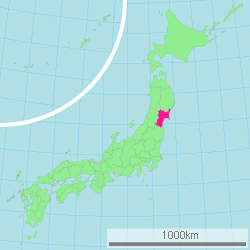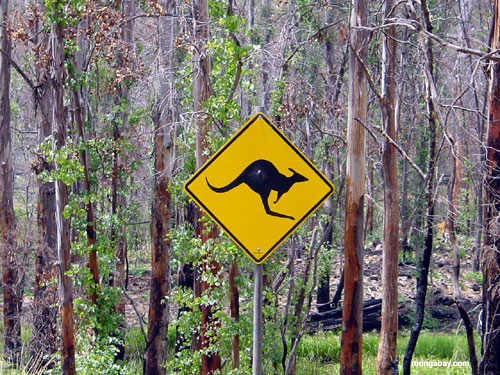
Miyagi Prefecture
March 15, 2011
The city of Sendai, which has been in the news lately due to the tsunami hitting there on March 11, 2011, is in the Miyagi Prefecture. Here is a posting on the Mystery Kangaroos of Miyagi written by Brent Swancer over a year ago for Cryptomundo. It makes sense to reprint it now, to refresh your memory of the cryptids of that area.
Loren
Mystery Kangaroos in Japan
by Brent Swancer
Japan has its fair share of natural beauty and unique fauna, but one thing that no one expects to find here is kangaroos in the wild. Yet this is exactly what bewildered residents have reported seeing in a rural community in Miyagi prefecture, which is located in northeastern Honshu, Japan.
The last months of 2009 in particular saw a spate of mysterious kangaroo sightings in the area around Ōsaki city, Miyagi prefecture, that have had authorities scratching their heads. Most of the sightings have occurred in and around the wilds of the rural Mayama district, which is known for its open fields, grassland, and pastures.
The first report of the year occurred on October 24, 2009, when a resident of the Mayama district spotted a kangaroo in the woods. The animal was described by the eyewitness as being around 1 meter (3.3 feet) in height, with beige colored fur and shining eyes. Several other separate reports of kangaroos began to come in over the following months. The most recent sighting occurred towards the end of December, when an elderly woman spotted a kangaroo bounding across an open field.
As amazing as these sightings are, the locale is not exactly new to kangaroos roaming its countryside, and in some ways the recent sightings could be seen as a recurrence of an ongoing phenomenon in the area. According to Etsuro Ishikawa, the head of Mayama’s community center, there have been at least 20 reports of kangaroo sightings in the area over the past seven years. This suggests that the animal is a rather long term resident, and has managed to survive on its own in this habitat. It is not clear whether these sightings have been of the same kangaroo, or if is a solitary animal or several.
Now obviously, kangaroos are not native to Japan. So how did one get there? What is going on here?
There have been no reports of missing kangaroos from zoos around the area, and the animals would find it a tough swim from Australia to Japan. This leaves us with the possibility of escapees or released pets. The probability of this is actually very high since currently the sale and rearing of kangaroos and wallabies aren’t subject to any regulations under Japanese law. In fact, these animals can regularly be seen openly for sale at pet shops throughout the country. Considering this, It certainly seems possible for an escaped or released exotic pet to be behind the reports.
Wherever it came from, there has been some speculation as to what species of kangaroo it could be as well as the odds that one could even survive for any appreciable length of time in Japan’s temperate climate.
Motoyasu Ida, a zoo official at the Ueno Zoo in Tokyo, Japan, thinks that the culprit could be an Eastern Grey Kangaroo (Macropus giganteus). Eastern Greys are relatives of the red kangaroo, and are found in Australia in the eastern half of Queensland, most of New South Wales and Victoria, and in parts of South Australia. They are a large species, with heights of up to 1.8 meters (6 feet), and weights of up to 60 kg (135lbs). This size fits in well with eyewitnesses estimates of the animal or animals as being anywhere from 1 meter (3.3 feet) to 1.8 meters (6 feet) tall, indicating that the kangaroo would be of a fairly large species. Eastern Greys also match the light grey to brown or beige coloration described in eyewitness reports of the mystery kangaroos.
Ida also thinks that an Eastern Grey would make a good candidate due to the species’ sturdiness and adaptability, a must for surviving long term through the area’s cold winters. He said, “If the body (of the mystery kangaroo) is as big as an Eastern Grey kangaroo, it would be able to maintain its body temperature, even when it’s cold.” Ida also remarked that even in the dead of winter, the Eastern Greys at Ueno zoo are remarkably active and like to spend a lot of time out of their enclosures in the cold.
Indeed, Eastern Greys are incredibly adaptable, which is a large part of the reason why they are one of the most ubiquitous and commonly seen species of kangaroo in their native range. If there is enough food, it seems at least plausible that a kangaroo of this type, or even a group of them could feasibly survive in this habitat.
Japanese zoologist, Hideo Obara, also seems to concur that some kangaroos can be very good survivors. Obara explained, “It wouldn’t be that unusual for a kangaroo to be living in Miyagi prefecture. Kangaroos are good at adapting to different environments and some species live in areas where the temperature gets below freezing.”
American cryptozoologist Loren Coleman doesn’t agree that a kangaroo is necessarily the culprit, and offered his own ideas on what could be behind the sightings. Coleman said, “Purely based on size alone, I have to disagree with the Japanese expert’s opinion. If this is a typical ‘out of place ‘roo report,’ the species described will not turn out to be a kangaroo, but a wallaby. As I note in my chapter on ‘mystery kangaroos’ or ‘phantom kangaroos’ in Mysterious America, there are wallabies adapted to colder climates that do well in northern locations. They are the ones that are most often, incorrectly, reported as kangaroos.”
There have been no photos or video footage taken of the phantom “kangaroos” at this point, so speculation is likely to remain for now on whether kangaroos or wallabies are behind the Japanese eyewitness accounts.
Despite the bizarre nature of this case, experts and authorities are taking the recent sightings seriously. In an effort to quell some residents’ fears, Obara has said that he doesn’t believe kangaroos on the loose in the area would pose any threat to the environment or to humans. Even so, residents have been warned that anyone seeing one of the kangaroos is not to approach the animal and to contact the proper authorities immediately.

The Kangaroo label sake locals are making in response to the recent sightings.
Whether these kangaroos or wallabies are dangerous or not, one enterprising local brand of Japanese liquor has decided to capitalize on all the publicity generated by the recent sightings. They have relabeled one of their lines of sake (Japanese rice wine) to feature a kangaroo prominently on front. The manufacturers hope to donate some of the proceeds towards the establishment of a kangaroo sanctuary in the area.
It looks like 2009 was a leap year for at least one rural community in Japan.

Will signs like this, not yet seen in Japan, be something to be placed there in the near future?
About Loren Coleman
Loren Coleman is one of the world’s leading cryptozoologists, some say “the” leading living cryptozoologist. Certainly, he is acknowledged as the current living American researcher and writer who has most popularized cryptozoology in the late 20th and early 21st centuries.
Starting his fieldwork and investigations in 1960, after traveling and trekking extensively in pursuit of cryptozoological mysteries, Coleman began writing to share his experiences in 1969. An honorary member of Ivan T. Sanderson’s Society for the Investigation of the Unexplained in the 1970s, Coleman has been bestowed with similar honorary memberships of the North Idaho College Cryptozoology Club in 1983, and in subsequent years, that of the British Columbia Scientific Cryptozoology Club, CryptoSafari International, and other international organizations. He was also a Life Member and Benefactor of the International Society of Cryptozoology (now-defunct).
Loren Coleman’s daily blog, as a member of the Cryptomundo Team, served as an ongoing avenue of communication for the ever-growing body of cryptozoo news from 2005 through 2013. He returned as an infrequent contributor beginning Halloween week of 2015.
Coleman is the founder in 2003, and current director of the International Cryptozoology Museum in Portland, Maine.
Filed under Breaking News, Cryptomundo Exclusive, Cryptotourism, CryptoZoo News, Eyewitness Accounts, Guest Blog, Out of Place, Weird Animal News